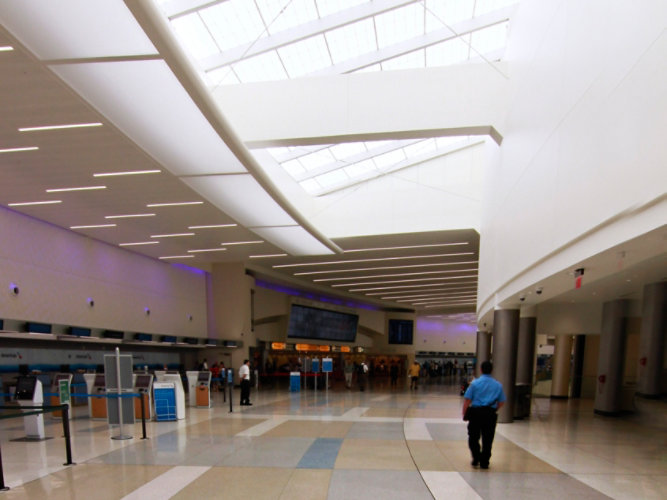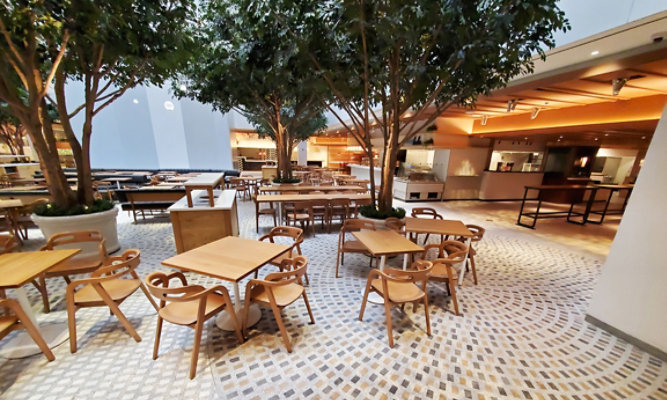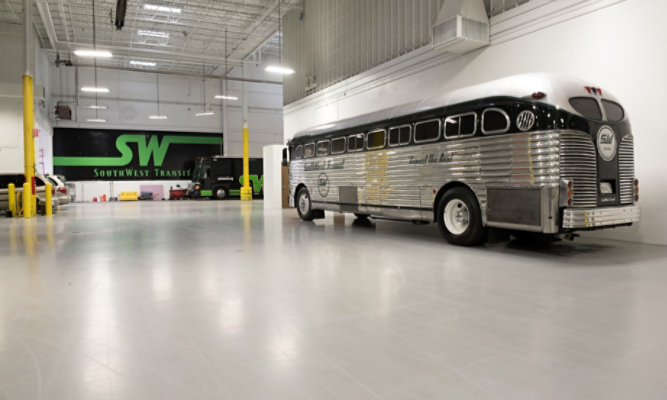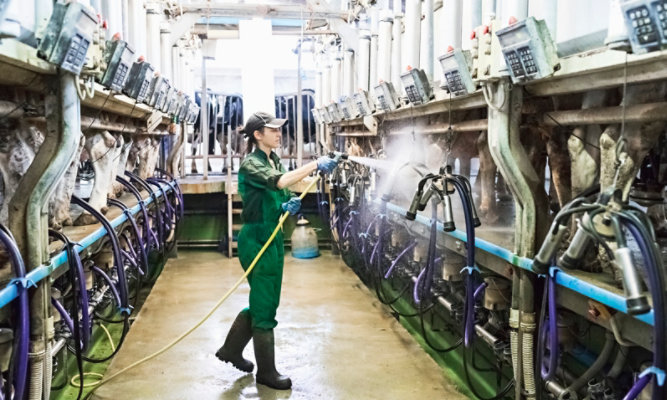Which Floors Should Not Be Epoxy Coated?
The majority of commercial, industrial and institutional floor substrates can be very successfully coated with decorative epoxy or other type of seamless high performance flooring system. However, there are some surfaces that are less suited. Read our guide on where installation of seamless epoxy coatings and resinous floor system is best avoided.
Learn More or Get a Free Flooring Evaluation

Epoxy floor coatings and other resinous flooring systems provide exciting aesthetic options, as well as numerous functional benefits, to nearly every type of facility. Additionally, informed facility managers find their life cycle values equally enticing. Will one of these innovative flooring systems work in the space you have in mind? If one of the below conditions describes conditions in your facility, careful consideration is warranted.
Structurally Compromised Concrete Floors
The integrity of a floor slab can be compromised early on as a result of a poor concrete mix during the initial pour or undesirable environmental conditions during the concrete curing period. Likewise, events such as earthquakes or severe storms can cause basic structural damage to the floor slab and building.
Uncoated Floors
Uncoated or insufficiently protected concrete floors can break down quickly, depending on facility use. Floors in places such as busy warehouses and production areas tend to experience heavy loads, frequent abrasion, chemical spills and/or severe impact. Without the benefit of performance coatings possessing high compressive strength, the ability to withstand severe impact, abrasion and/or chemical exposure, the floor slab can suffer severe damage that’s difficult to repair.
If caught early enough, a concrete floor with an impaired or deteriorated surface can be restored by an experienced professional epoxy flooring contractor before the damage ends up compromising the entire slab structure. In addition to resin based, whole-floor resurfacers, the tool box of a skilled pro may include an economical cementitious patching product, which can be installed to full slab depth in specific areas if needed. The epoxy floor cost can be minimized with timely repair and restoration, saving hundreds or thousands of dollars over replacing the entire concrete slab.
Wood Floors
Wood floors, depending on their age, type and construction, tend to move and flex—an undesirable condition for installation of standard epoxy and other resinous flooring systems. These relatively rigid traffic surfaces do best when applied to similarly inflexible concrete substrates.
Polymer flooring that incorporates elastomeric resins and/or underlayments can help absorb movement and vibration. Installers should nevertheless be aware that many “wood” construction products now contain various types of glues, adhesives and other chemicals that can interfere with the proper bond of epoxy and other floor coatings. Therefore, careful evaluation of the wood material itself is needed.
Tile Floors
Many people ask resinous flooring installers if epoxy or other fluid-applied flooring can be installed over various types of existing tile. The answer to this can change with the type, age and condition of the tile. For an epoxy coating or other resinous topping to adhere well to tile of any kind, proper evaluation of site conditions, as well as careful mechanical preparation is needed.
Ceramic Tile Floors
Ceramic tile, as seen in restrooms, locker rooms, offices, entryways and similar areas, is typically glazed, hard fired and often very slick. Individual tile sizes can range from less than a square inch, to greater than four feet square. The grout holding the system together can be polymer based or completely cementitious, and is typically present underneath, as well as between, the tiles.
Installing resinous flooring over a ceramic tile and grout floor can be challenging. In preparation for coating, the slick tile surface must be removed by mechanical means, such as shot-blasting or diamond-grinding. In some cases, this can end up compromising the grout system, as well as cause tiles to crack or pop out, resulting in the need for extensive repair and patching before the coating system can be installed.
Gaps must then be filled and repaired prior to installation of the epoxy floor coating, which, in turn, can add unbudgeted man hours to the project. In the end, many flooring contractors find that complete removal of ceramic tile at the outset is the more efficient and economical approach.
Quarry Tile
Quarry tile floors found in older commercial kitchens can often be professionally coated with great results. Because the surface is unglazed and more “open,” experienced resinous flooring contractors can do an excellent job of shot-blasting or grinding the surface and installing a proven high performance food facility flooring system, such as one comprised of cementitious urethane. In contrast to the old quarry tile with its numerous porous grout lines, the new monolithic, virtually seamless urethane mortar surface can provide improved facility hygiene and better cleanability.
Luxury Vinyl Tile (LVT) and Vinyl Plank
Luxury Vinyl Tile (LVT) and Vinyl Plank floors are engineered systems made up of patterned and/or printed vinyl film laminated to composite wood or plastic sub-structures. Individual tile or plank pieces are designed to fit/ lock together across the floor, enabling typical installation to take place with very little to no use of adhesives. The seams of vinyl plank floors are sometimes heat-welded. The final result is a slightly raised floor.
LVT and vinyl plank flooring is made up of multiple parts that can often flex and move. In addition, it is manufactured using a variety of different materials and adhesives that may or may not be compatible with resinous coatings. It’s therefore best, when considering a high performance seamless system, to completely remove the LVT or planks. Resinous flooring installers can then proceed to evaluate and prepare the concrete substrate prior to coating.
Vinyl Composition Tile (VCT), Sheeting and Linoleum
Vinyl Composition Tile (VCT) is comprised of flat, typically square, synthetic tiles that get glued down directly to the substrate. Vinyl sheeting is made of similar material, but is furnished in large rolls and cut during installation to fit the shape of the room. The same tile and sheet configurations are available in more sustainable linoleum products, which are derived from linseed oil.
Older VCT and linoleum flooring installed twenty or more years ago often remains firmly bonded to its concrete substrate to this day, thanks to old generation, solvent-based mastic adhesives. If the old tile or sheeting can actually be lifted, the remaining black mastic tends to be extremely difficult to remove from the substrate. So long as there is no asbestos content, experienced installers have been known to lightly grind the worn, desiccated vinyl or linoleum surface and successfully coat with resinous coatings. Note that the square tile pattern may transfer through and be noticeable through the coating system. Installing a test patch to work out application technique before proceeding to coat the entire floor is highly recommended.
In contrast, for newer vinyl and linoleum floors, resinous coating manufacturers often recommend complete removal. The reasons are two-fold: 1) More recently installed vinyl or linoleum flooring is likely to be bonded to the floor using newer, EPA-mandated, water-based adhesives, which tend to be much easier to remove than the old fashioned mastic, 2) The newer tiles or sheeting may still contain significant amounts of the plasticizer and/or oil ingredients used in their manufacture, which could compromise the bond of subsequent epoxy coatings.
Asbestos Tile
Because substrate preparation necessitates grinding or abrading the existing tile surface, it’s best to avoid coating over old asbestos tile. The resulting asbestos dust is a dangerous health risk and an environmental hazard. It’s best to leave this work to licensed asbestos remediation companies.
Professional Floor Preparation Prior to Epoxy Coatings
While it is unwise to install epoxy floor coatings over structurally unsound concrete, and while application of resinous flooring over wood or ceramic tile must be carefully considered, other types of substrates also require experienced professional floor preparation and installation. These include:
- Newly poured concrete floors
- Floors with potential moisture vapor issues
- Floors in facilities with extreme temperatures
- Concrete floors with sealers or hardeners
- Previously coated floors
Luckily, special preparation techniques are available to deal with each of these conditions.An epoxy coating or other resinous floor system is only as good as the concrete underneath. We’re ready to provide you with epoxy floor coating preparation based on your needs, and determine whether your flooring should be epoxy coated or might benefit from another type of resinous system. For a consultation about options for your unique facility floor, contact the Sherwin-Williams team.
Discover More
Industry Expertise and Innovation
See how we help customers find customized solutions for their project and application challenges.
System Lookup
Find out more about our innovative floor systems for a variety of industries.
FIND A SYSTEM

